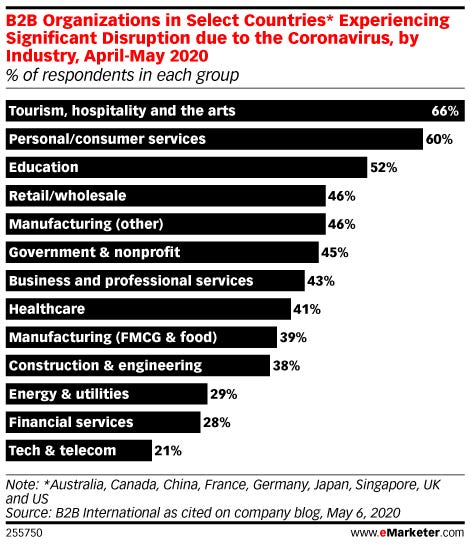Just as consumers are adjusting to life during the pandemic, B2Bs are figuring out how to stay in business, operate and recover. This often requires a digital transformation of marketing and sales efforts.
The rippling impact differs greatly by sector. Two-thirds of B2Bs from the tourism and hospitality category said they saw substantial disturbance to their business. Other hard-hit B2B segments include personal services (60%), education (52%), wholesale (46%) and manufacturing (46%). The B2B sectors experiencing minimal impact, albeit compared with others, were tech and telecom (21%), financial services (28%) and energy and utilities (29%).
Uncertainty was a central theme for B2B respondents from an earlier wave of B2B International research: 58% noted they were worried about sales and revenues, 56% were concerned about cash flow and liquidity and 52% cited the disruption to executing their business strategy.
Through the month of April, outlooks for the economic conditions post-pandemic shifted from a positive to neutral stance across US B2B professionals surveyed by McKinsey & Company. At the start of the month, 55% of respondents said they were optimistic or confident the economy would rebound in two to three months and grow just as strong or even stronger than before the pandemic; while 33% had a neutral position, meaning they thought the economy would be affected for six to 12 months or longer and then be stagnate or show slow growth post-pandemic; and 11% were pessimistic and thought the current circumstances would have a lasting impact on the economy and cause a lengthy recession. At the end of the month, fewer respondents were optimistic, although half still felt confident, but there was a jump to 41% in respondents who were more neutral about the future.
A potential advantage for B2B companies, over their business-to-consumer (B2C) counterparts, is that B2Bs had an easier shift to remote work, according to a March 2020 survey from Marketing Week and Econsultancy. Roughly a third of B2C marketers said their business was proficient in working from home, whereas 51% of B2B companies thought their company was prepared to enable working remotely.
With teams working from home and economic challenges ahead, the question is how much of the recent change—to business and everyday life—will be permanent. We don’t know the answers or have a timeline for recovery—no one does. But our recent report focuses on eight areas of B2B business that have changed since the start of the pandemic. It will examine what early shifts were made, lessons learned and how companies should consider long-term digital transformation for a post-pandemic world.




Average Rating